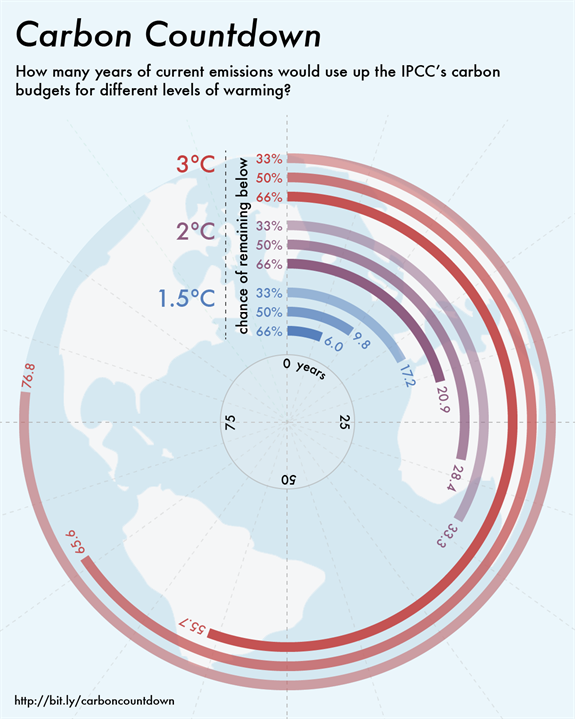We've spent the entire semester working under the premise that we need to reduce emissions and we need to do so quickly. The global carbon budget concept helps us understand not only why emissions reductions are important, but more specifically, why they are urgently important.
In 2013, the IPCC released the fifth assessment report - IPCC, 2013: Climate Change 2013: The Physical Science Basis. Contribution of Working Group I to the Fifth Assessment Report of the Intergovernmental Panel on Climate Change which included an overall cap on the cumulative anthropogenic emissions of greenhouse gases possible since industrialization before we hit 2 degrees of warming and the catastrophic impacts it brings along with it. That number? A trillion metric tons. That number is arguably too big for most of us to comprehend, especially as we're thinking about it over a several centuries-long time frame. (If you're curious you can watch this real-time tracker at www.trillionthtonne.org to see where we currently stand.) At the time the report was released in 2013, based on the previous several decades of emissions, they estimated we'd hit that trillionth tonne of emissions somewhere in late November 2040.
This short video (2:21) offers a concise explanation of the carbon budget. Take a look.PRESENTER: Increased carbon in the atmosphere warms the planet. Scientists estimate that humans cannot add more than 1 trillion tons, also known as 1,000 gigatons, of carbon to the atmosphere to stay below two degrees of global warming. The basic understanding is that beyond two degrees of warming, humanity will no longer have the ability to control warming trends, in part due to the release of methane currently trapped beneath the arctic permafrost.
From the beginning of the Industrial Revolution, we've spent about 515 gigatons, leaving us with 485 gigatons of carbon left to emit before hitting that two-degree warming barrier. The first half of our budget was spent over the past 200 years to build the society in which we live today. However, due to a consistently increasingly carbon-intensive world, if current trends continue, the 485 gigatons left in the budget will be spent in as little as the next 30 years.
Any use of what is left of our carbon budget that would increase our dependence on fossil fuels is akin to spending your last few dollars to cover the upfront cost of a payday loan. It may make everything look better for the time being, but when collection time rolls around, you've put yourself in a position where you are now at the mercy of external forces. And if you can't pay, mother nature just might break your kneecaps.
This means we only have 30 years to completely phase out the widespread use of fossil fuels. Therefore, as we move forward, the central policy question must be how we can expedite the decarbonization of our world so as to avoid spending it all.
The carbon budget helps us understand how much carbon we have left to 'spend' before we commit ourselves to various levels of warning. But what does that look like? Let's try to interpret these results. At current (2014 when this graphic was created) emissions levels, we had just 6 years before we reached that budget if we want to confidently contain warming to 1.5 degrees. If we decide we're ok with just shooting for 2 degrees, that stretches our budget out to about 20 years.

| 1.5ºC | 2ºC | 3ºC | |||||||
|---|---|---|---|---|---|---|---|---|---|
| Chance of Remaining Below | 66% | 50% | 33% | 66% | 50% | 33% | 66% | 50% | 33% |
| Years | 6.0 | 9.8 | 17.2 | 20.9 | 28.4 | 33.3 | 55.7 | 65.6 | 76.8 |
Tell me more about carbon budgets
If you want to know more about carbon budgets, see WRI's According to New IPCC Report, the World is on Track to Exceed its Carbon Budget in 12 Years (Levin, 2018).
